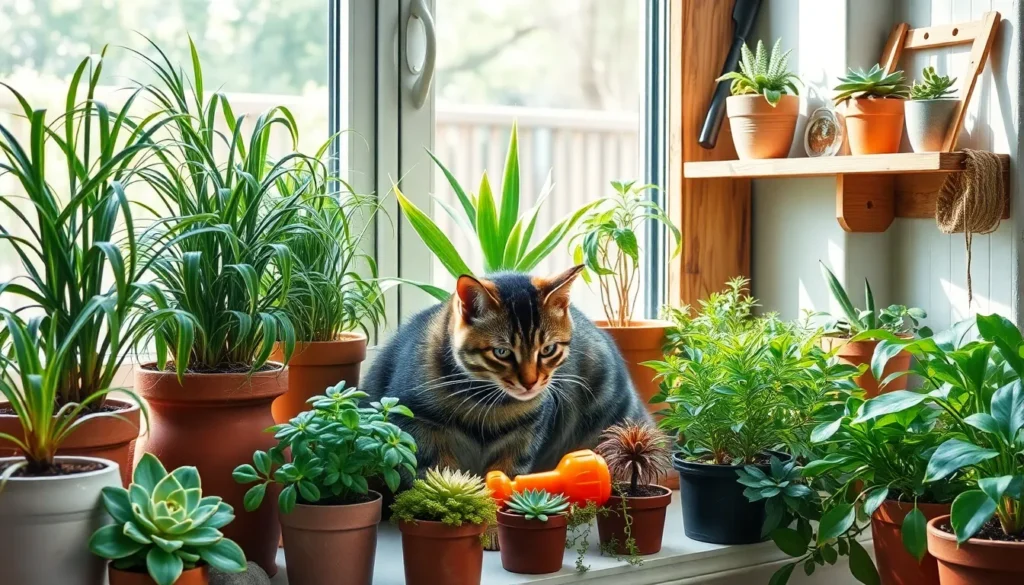We’ve all been there – you wake up to find your beautiful houseplants turned into your cat’s personal playground. Soil scattered across the floor, leaves chewed to bits, and that guilty feline face that says “I regret nothing.” It’s frustrating when our beloved pets treat our green sanctuaries like their own personal entertainment center.
The good news? You don’t have to choose between your plants and your cat. With the right strategies, we can create a harmonious home where both flourish. From simple deterrents to clever placement tricks, there are proven methods that’ll protect your plants without harming your furry friend.
Whether you’re dealing with a serial plant digger or a curious kitten who can’t resist batting at hanging leaves, we’ll show you exactly how to cat-proof your indoor garden and maintain that peaceful coexistence you’re after.
Understanding Why Cats Are Attracted to Plants
Before we can effectively protect our plants, we need to understand what draws our feline friends to them in the first place.
Natural Instincts and Behaviors
Cats view our houseplants as natural playgrounds that satisfy their deepest instincts. They’re hardwired to hunt and explore, making the rustling leaves and swaying stems irresistible targets for pouncing and batting. Our indoor cats lack access to outdoor vegetation, so they turn to houseplants to fulfill their need to nibble on greenery for digestive health.
Territory marking drives much of this plant attraction, as cats rub against leaves and stems to deposit their scent. Digging behavior comes naturally to them, and loose potting soil provides the perfect substitute for outdoor dirt. Curiosity compels cats to investigate new plants we bring home, while the texture of certain leaves triggers their grooming instincts.
Common Plant Types That Appeal to Cats
Spider plants top the list of feline favorites due to their long, dangling leaves that move like prey. These plants contain compounds similar to catnip that create mild euphoric effects in many cats. Grass-like plants such as cat grass, wheat grass, and bamboo palm attract cats seeking to supplement their diet with roughage.
Succulents appeal to cats because of their interesting textures and compact size that’s perfect for batting. Plants with feathery or fuzzy foliage like Boston ferns and African violets trigger hunting instincts. Trailing plants including pothos and philodendrons become irresistible toys when their vines dangle within reach.
Health Risks for Both Cats and Plants
Toxic plants pose serious health threats to our cats, with some causing mild stomach upset while others can be fatal. Common houseplants like lilies, azaleas, and sago palms contain compounds that damage kidneys, cause neurological problems, or lead to heart failure in cats. Even non-toxic plants can cause digestive issues when consumed in large quantities.
Our plants suffer important damage from cat interactions, including broken stems, chewed leaves, and disturbed root systems. Cats digging in soil can expose roots to air and damage delicate feeder roots that plants need for nutrient absorption. Urine contains high levels of nitrogen that burns plant tissue and can kill smaller plants entirely. Repeated interactions stress plants and make them more susceptible to diseases and pest infestations.
Creating Physical Barriers Around Your Plants
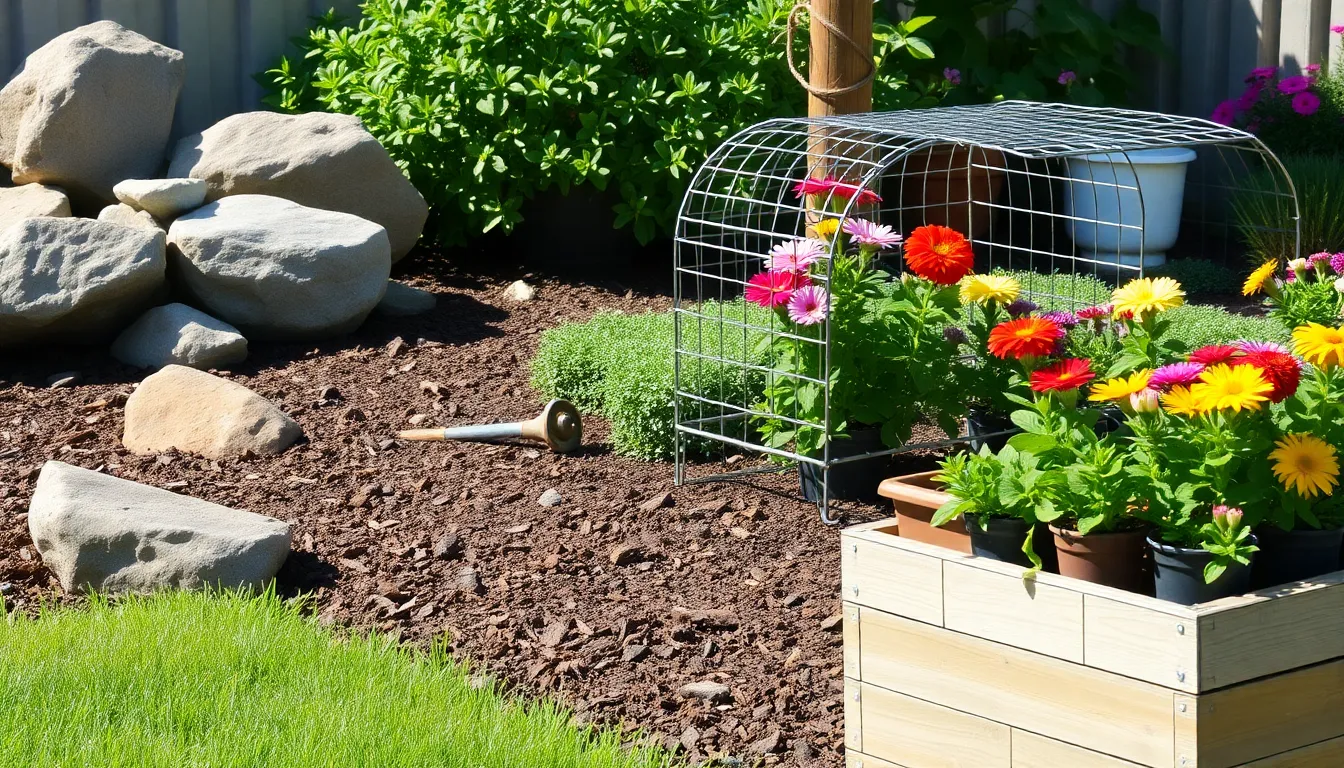
Physical barriers offer the most reliable defense against curious cats while maintaining easy access for plant care. These protective measures create clear boundaries that discourage feline exploration without compromising your plants’ health.
Using Decorative Rocks and Mulch
Large flat decorative rocks placed strategically on soil surfaces prevent cats from digging or using flower beds as litter boxes. We recommend choosing rocks that completely cover the soil while leaving space around plant stems for growth and watering.
Heavy gardening mulch creates an uncomfortable texture that cats typically avoid. Bark chips, pinecones, or specialized mesh materials work effectively when layered on top of soil to make digging unpleasant for cats.
Avoid small gravel or fine bark mulch as some cats find these materials enjoyable to dig through. Instead, opt for larger, irregular shaped materials that feel awkward under their paws.
Installing Plant Cages and Wire Covers
Plant cages and wire covers completely enclose plants while allowing essential light and air circulation. These protective barriers prevent direct access without causing harm to cats who attempt to investigate.
Wire mesh systems work particularly well for both indoor and outdoor plants, especially when protecting sensitive or high value specimens. We suggest choosing mesh with openings large enough for watering but small enough to prevent paw access.
Greenhouse style covers can protect entire garden beds by creating a physical barrier that blocks cats while offering weather protection for plants.
Implementing Raised Planters and Hanging Gardens
Raised planters create height barriers that many cats cannot easily overcome while improving drainage and soil quality. These elevated growing spaces position plants beyond typical jumping reach for most felines.
Hanging gardens and planters keep vegetation well above ground level, completely removing them from curious cat exploration. Mount these containers securely to prevent accidents if cats attempt to jump or climb nearby structures.
Strategic plant placement at varying heights creates visual interest while maintaining practical protection. Combine raised and hanging options to establish multiple protection zones throughout your space.
Applying Natural Cat Deterrent Scents
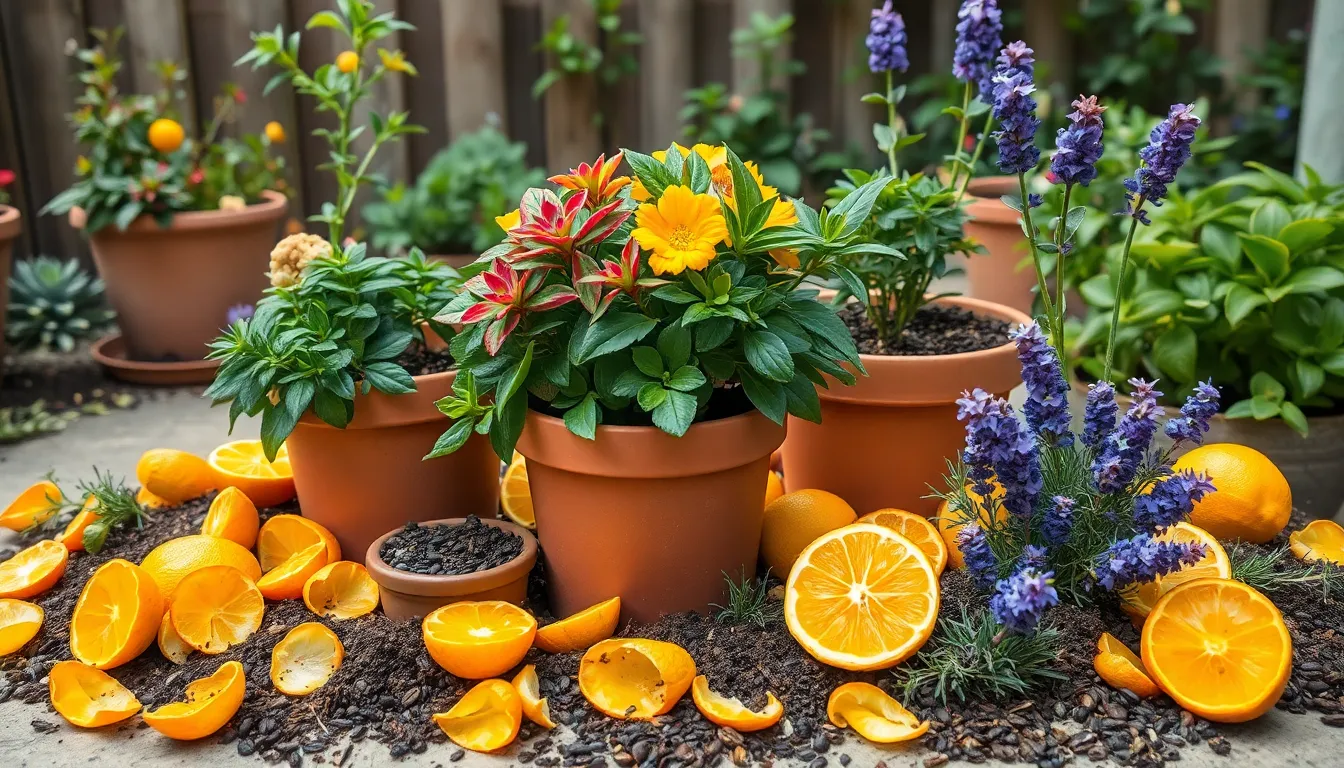
Natural scents offer an effective way to keep cats away from plants without using harsh chemicals. We can create homemade deterrent sprays by mixing 2 oz of water with just two drops of essential oils like citrus, rosemary, or lavender.
Citrus Peels and Essential Oils
Cats strongly dislike the scent of citrus fruits, making oranges and lemons our most powerful natural allies. Scatter fresh citrus peels around garden beds or houseplant pots after enjoying the fruit, and they’ll serve double duty as both deterrent and fertilizer. Essential oils derived from these fruits work even better when properly diluted and sprayed near plants to enhance the protective effect.
Orange peels work particularly well because their oils release a strong aroma that cats find overwhelming. Lemon peels create an equally effective barrier while breaking down slowly to nourish the soil. We recommend replacing the peels every few days to maintain their potency and fresh scent.
Coffee Grounds and Used Tea Bags
Coffee grounds provide an excellent natural repellent due to their strong, bitter odor that cats instinctively avoid. Mix dried mustard, coffee grounds, and rosemary to create a powerful mixture that benefits soil health while keeping cats at bay. Used tea bags work equally well when placed strategically around plant bases or sprinkled as loose leaves throughout the growing area.
Fresh coffee grounds work best for deterrence, though day old grounds still maintain enough scent to be effective. Tea bags from black or green tea varieties provide the strongest deterrent effect compared to herbal teas. We suggest applying these materials in thin layers to avoid overwhelming the plants while maximizing their cat repelling properties.
Herbs That Cats Naturally Avoid
Planting exact herbs creates a natural barrier that cats won’t cross, protecting our favorite plants year round. Strategic placement of these deterrent herbs around gardens or indoor plants establishes an effective defense system.
| Herb | Active Component | Effectiveness | Safety Notes |
|---|---|---|---|
| Rosemary | Strong aromatic oils | High deterrent effect | Safe for cats and plants |
| Lavender | Floral compounds | Moderate to high | Non-toxic, pleasant for humans |
| Citronella | Essential oils | Very high | Strong scent may overwhelm some people |
| Lemongrass | Citrus compounds | High | Safe alternative to citronella |
| Oregano | Carvacrol | High | Use cautiously – can be toxic if ingested |
| Geraniums | Floral scent + texture | Moderate | Prickly leaves add physical deterrent |
Rosemary stands out as our top choice because its woody scent effectively repels cats while remaining completely safe for both pets and plants. Lavender offers the added benefit of creating a pleasant aroma for humans while maintaining strong deterrent properties. Citronella and lemongrass work exceptionally well due to their essential oil content, though we recommend testing tolerance levels first since their scents can be quite powerful.
Utilizing Motion-Activated Deterrent Devices
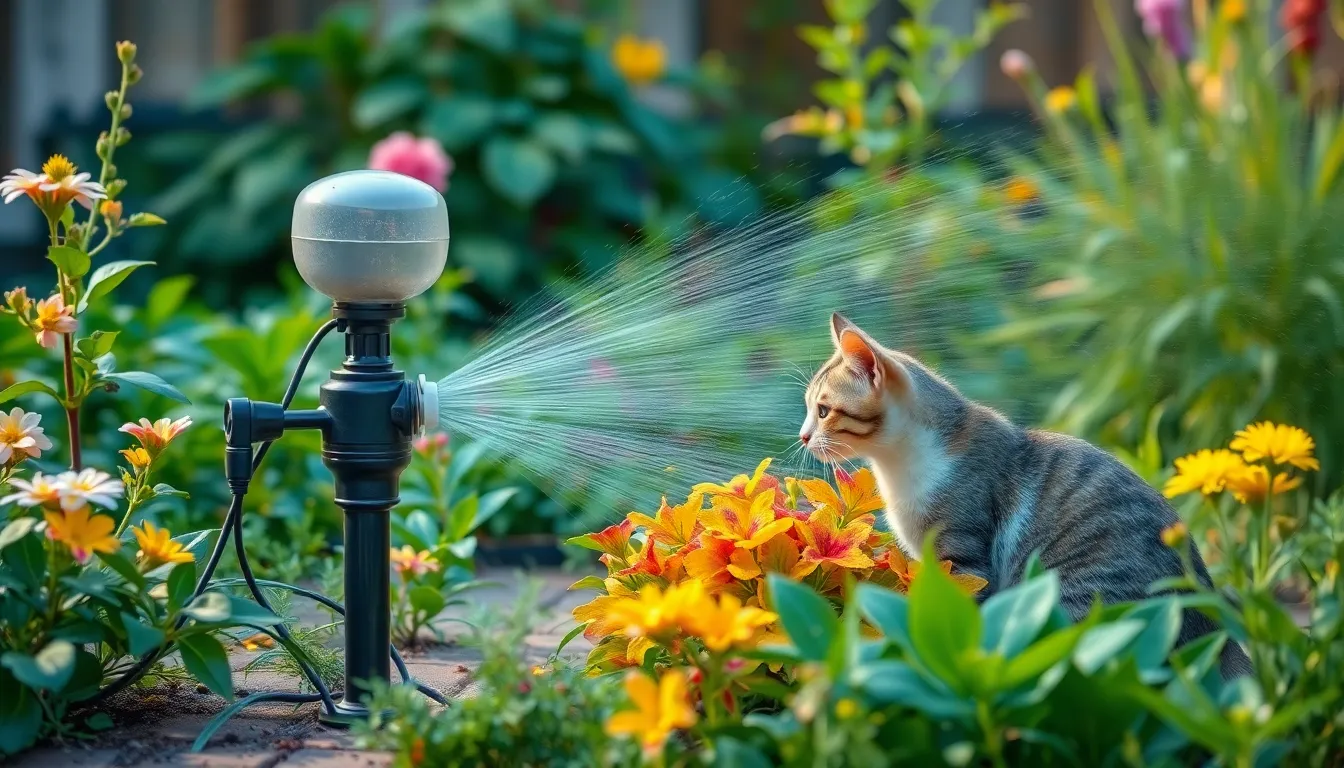
Motion-activated deterrent devices provide an automated solution that responds instantly when cats approach our plants. These systems work by detecting movement and triggering a harmless but startling response that encourages cats to avoid the area.
Sprinkler Systems for Outdoor Gardens
Automatic sprinkler systems offer practical protection for larger garden spaces where cats frequently wander. When sensors detect movement, they release a spray of water that cats naturally dislike and will avoid in future visits. Motion-activated sprinklers work efficiently without constant supervision, making them ideal for outdoor areas where we can’t monitor cat activity throughout the day. We can position these systems strategically around vulnerable plants or garden beds to create invisible boundaries that cats learn to respect. The water spray startles cats without causing harm, teaching them to associate our garden areas with an unpleasant experience they’ll want to avoid.
Ultrasonic Sound Devices
Ultrasonic devices emit high-frequency sounds that remain inaudible to humans but create discomfort for cats in the targeted area. These sounds discourage cats from entering spaces where we’ve placed the devices, though some cats may become accustomed to the noise over time. We find these devices work most effectively when combined with other deterrent methods rather than used alone. Strategic placement near plant clusters or garden entrances maximizes their effectiveness in protecting our green spaces. The technology provides continuous protection without requiring daily maintenance or refilling like other deterrent options.
Motion-Sensor Air Sprays
Motion-sensor air sprays detect approaching cats and release harmless puffs of air that startle them away from our plants. These devices encourage cats to leave the area immediately after experiencing the unexpected air burst, creating a negative association with the location. We can position these compact units near individual plants or small garden sections where cats frequently cause problems. The air spray method works particularly well for indoor plants since it doesn’t involve water that could damage furniture or flooring. Battery-operated models offer flexibility in placement without requiring electrical outlets near our plant displays.
Modifying Your Plant Care Routine
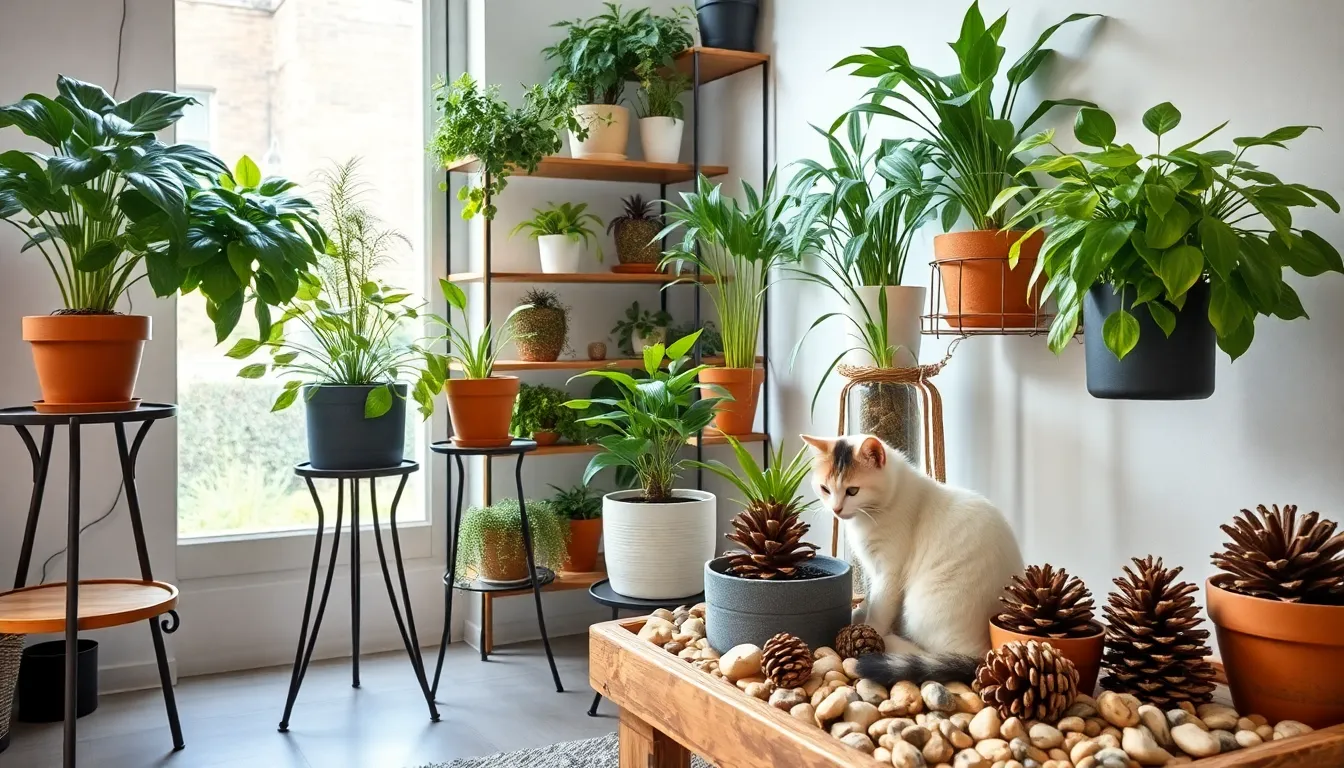
Sometimes the most effective answers come from adjusting our daily plant care habits rather than adding new deterrents. Strategic changes to how we water, manage soil, and position our plants can significantly reduce feline interference.
Adjusting Watering Schedules and Methods
Cats gravitate toward moist, freshly watered soil because it’s easier to dig and more appealing for their bathroom needs. We can discourage this behavior by switching to bottom watering methods that keep the soil surface drier for longer periods.
Drip irrigation systems work exceptionally well for this purpose, delivering water directly to the root zone while maintaining a less attractive surface layer. Bottom watering through saucers or trays achieves similar results by allowing plants to absorb moisture from below.
Timing our watering sessions strategically also helps minimize cat interest. We recommend watering early in the morning when cats are typically less active, giving the soil surface time to dry before peak exploration hours.
Changing Soil Types and Textures
Soil texture modifications create an unwelcoming environment for curious paws without harming our plants. Cats prefer soft, loose soil that’s easy to dig through, so we can make strategic adjustments to discourage their interest.
Adding coarser materials like perlite or small gravel to our potting mix creates an unpleasant texture that cats avoid. Decorative stones or river rocks spread across the soil surface provide both aesthetic appeal and functional deterrence.
We’ve found that covering soil entirely with physical barriers works exceptionally well. Pinecones create natural spikes that cats find uncomfortable to walk on, while bamboo chopsticks inserted vertically around plants form an effective grid system. Large decorative rocks not only prevent digging but also add visual interest to our plant displays.
Relocating Plants to Cat-Proof Areas
Strategic placement often proves more effective than any deterrent method we can apply. Elevating plants beyond our cats’ reach eliminates most interaction opportunities while showcasing our green friends beautifully.
Hanging planters and macrame holders transform vertical wall space into thriving plant displays that cats simply can’t access. Tall plant stands and shelving units create multi level gardens that keep foliage safely out of paw’s reach.
We recommend creating dedicated plant zones in rooms where we can control access more easily. Glass cabinets, terrariums, and DIY greenhouse setups provide complete protection while maintaining visibility and proper growing conditions.
Wrapping pot edges with aluminum foil creates an immediate deterrent since cats dislike both the texture and crinkly sound it produces. This simple modification requires minimal effort but delivers consistent results for floor level plants we can’t relocate.
Providing Alternative Entertainment for Your Cat
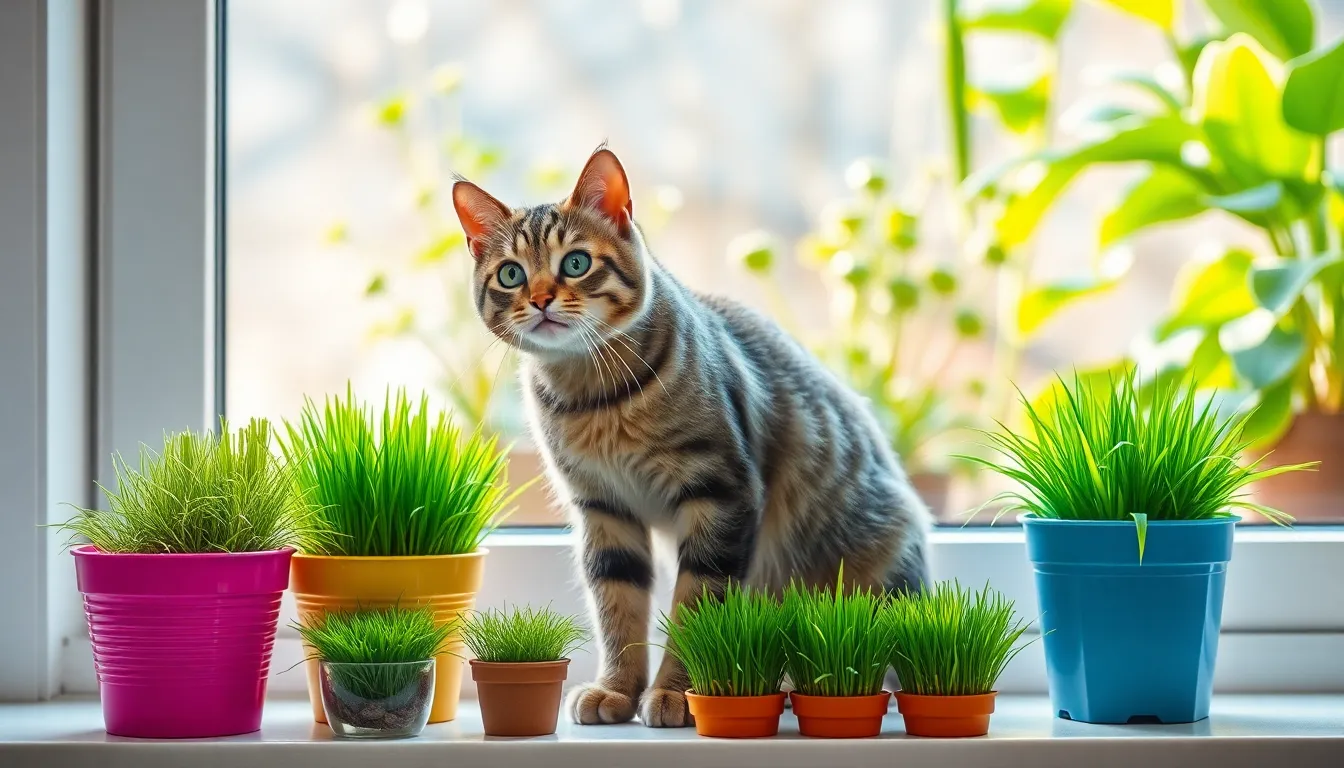
Rather than constantly deterring cats from your plants, we can redirect their attention by offering captivating alternatives that satisfy their natural instincts. This positive approach creates a win-win situation where cats get the stimulation they crave while your plants remain protected.
Cat-Safe Plants and Grass Options
Catnip and cat grass serve as excellent plant alternatives that naturally draw cats away from your prized houseplants. These cat-friendly options act as magnets, concentrating your feline’s attention on designated areas rather than your main plant collection. We recommend placing pots of catnip in strategic locations to create focal points that satisfy your cat’s plant interaction needs.
Cat grass provides essential nutrients while giving cats the greenery they instinctively seek. Spider grass, wheat grass, and oat grass varieties offer safe chewing options that support digestive health. Growing multiple pots ensures a continuous supply as cats consume these beneficial plants.
Strategic placement maximizes effectiveness when positioning cat-safe plants throughout your home. Corner locations, windowsills, and areas near your cat’s favorite lounging spots work particularly well. We’ve found that rotating fresh pots every few weeks maintains your cat’s interest and prevents them from seeking out other plant options.
Interactive Toys and Climbing Structures
Cat trees and climbing structures address vertical territory needs that might otherwise lead cats to explore plant shelves and hanging baskets. Multi-level cat towers provide exercise opportunities while satisfying natural climbing instincts. These structures become preferred destinations when positioned near windows or in rooms with plants.
Interactive puzzle toys engage hunting instincts that cats might otherwise direct toward plant leaves and soil. Feather wands, laser pointers, and treat-dispensing toys offer mental stimulation that reduces boredom-related plant destruction. We suggest rotating toys weekly to maintain novelty and interest.
Scratching posts fulfill territorial marking behaviors that can prevent cats from using plant pots for claw maintenance. Sisal rope posts, cardboard scratchers, and wooden scratching surfaces give cats appropriate outlets for this natural behavior. Placing these near plant areas creates positive associations with approved scratching locations.
Designated Digging Areas and Sandboxes
Indoor digging boxes satisfy excavation instincts that often lead cats to disturb potted plant soil. Fill shallow containers with soft sand, potting soil, or cat-safe substrate to create appealing digging zones. These designated areas prevent cats from treating your plant pots as personal excavation sites.
Outdoor sandbox installations work effectively for cats with garden access who might otherwise dig in flower beds. Choose locations away from your main plantings but easily accessible to your cat. Adding catnip or cat grass seeds to sandbox areas increases their appeal and usage frequency.
Substrate selection influences digging preference since cats favor soft, easily moveable materials. Fine sand, loose potting mix, and shredded paper create inviting textures that cats prefer over harder soil surfaces. We recommend refreshing digging areas weekly to maintain cleanliness and appeal.
Training Your Cat with Positive Reinforcement
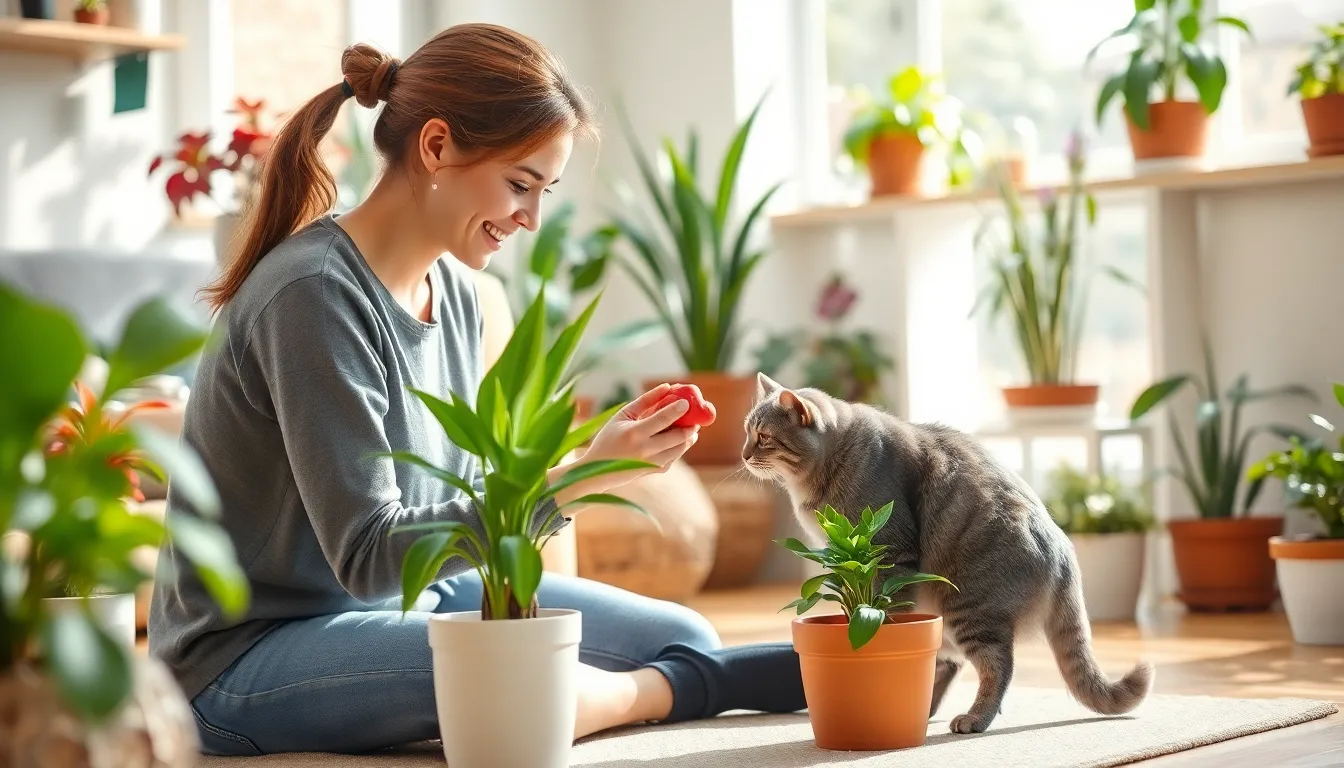
Training offers a long-term solution that transforms your cat’s relationship with houseplants. We’ll explore proven methods that use your cat’s natural learning abilities to create lasting behavioral changes.
Reward-Based Behavior Modification
Immediate rewards work best when your cat displays the desired behavior of staying away from plants. Treats, petting, playtime, or catnip serve as effective motivators depending on what your cat finds most appealing. Give rewards within seconds of the positive behavior to help your cat make the connection between ignoring plants and receiving something wonderful.
Timing becomes crucial for successful behavior modification. We must deliver rewards immediately when cats choose to play elsewhere instead of investigating plants. This quick response helps cats associate their good choices with positive outcomes.
Redirect unwanted plant interactions rather than simply saying no. When your cat approaches plants, guide them toward acceptable alternatives like scratching posts or designated play areas. Reward them enthusiastically when they engage with these approved items instead of your houseplants.
Avoid rewarding attention-seeking behaviors around plants. Don’t react positively when cats chew leaves or dig in soil, as this attention can accidentally reinforce the unwanted behavior. Instead, calmly redirect and reward appropriate activities.
Consistent Commands and Boundaries
Clear verbal commands help establish plant boundaries effectively. Teach your cat a firm “No” specifically for plant-related activities, using the same tone and word every time. Consistency from all family members ensures your cat receives the same message regardless of who’s present.
Environmental management supports your training efforts significantly. Make plants less accessible while teaching boundaries by using physical barriers or strategic placement. This combination of training and environmental control creates multiple layers of protection.
Pair commands with immediate redirection for better results. After saying “No” to plant exploration, immediately guide your cat to an appropriate activity and reward their compliance. This teaches them what they should do instead of just what they shouldn’t do.
Maintain training consistency even when you’re not watching. Use deterrent methods like motion-activated devices to reinforce boundaries when you can’t supervise directly. This creates a reliable environment where plant rules always apply.
Professional Training Resources
Professional cat behaviorists provide customized answers for persistent plant problems. These experts assess your exact situation and create customized training plans based on your cat’s temperament and motivation. They often use advanced positive reinforcement techniques that prove more effective than general approaches.
Certified animal trainers offer specialized programs for indoor cats. Many professionals focus on environmental enrichment strategies that reduce plant interest by addressing underlying behavioral needs. They can identify exact triggers that draw your cat to plants and develop targeted answers.
Operant conditioning techniques from professionals yield lasting results. Expert trainers use scientifically-backed methods that create permanent behavioral changes rather than temporary fixes. These approaches often combine multiple training strategies for comprehensive plant protection.
Group training classes help cats learn social boundaries. Some professional programs include multiple cats and owners, teaching both pets and people effective communication techniques. These sessions often address common household challenges beyond just plant protection.
Choosing Cat-Resistant Plant Varieties
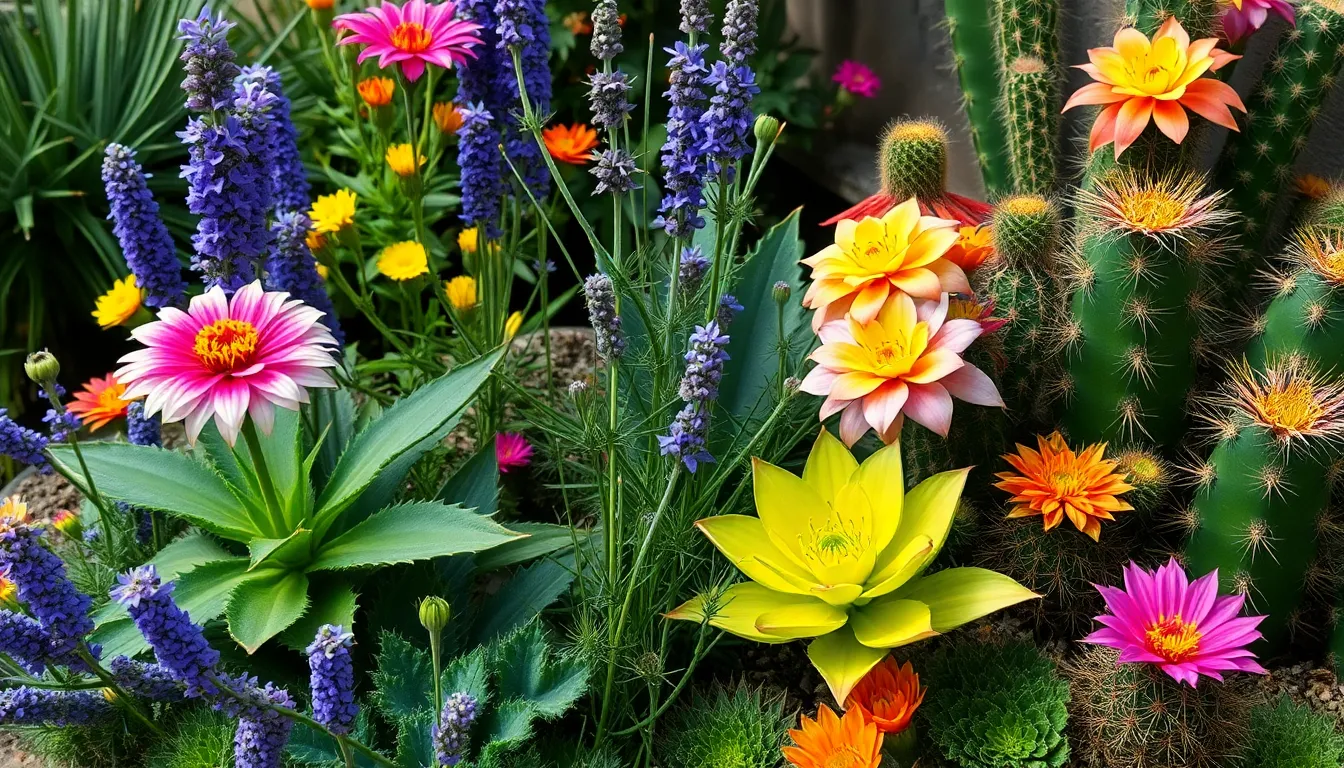
Building on deterrent methods and environmental modifications, we can select exact plant varieties that naturally discourage feline interference. Smart plant selection creates an additional layer of protection while maintaining our garden’s beauty.
Plants That Naturally Repel Cats
Aromatic deterrent plants offer a natural solution that keeps cats away through scent alone. The Scaredy cat plant (Coleus canina) stands out as the most effective option, emitting an odor resembling dog urine that cats actively avoid. This specialized plant grows up to 2 feet tall with attractive blue or purple flowers and requires minimal water due to its drought-resistant nature.
Traditional herb deterrents provide dual benefits for gardeners seeking multipurpose plants. Lavender creates beautiful purple blooms while releasing a fragrance that cats find unpleasant. Rosemary offers culinary value alongside its cat-repelling properties, thriving in sunny locations with minimal care requirements.
Specialized repellent varieties include rue, pennyroyal, curry herb, and citronella, each contributing unique scents that discourage cat visits. These plants establish natural boundaries around more vulnerable garden areas without requiring constant maintenance or replacement.
Low-Maintenance Alternatives
Spiky texture plants create physical barriers that cats naturally avoid without causing harm. Cacti varieties like Saguaro, Golden Barrel, and Prickly Pear offer striking visual appeal while their spiny exteriors deter curious paws. These plants require watering only when soil becomes completely dry, making them perfect for busy gardeners.
Rigid leaf succulents provide another excellent deterrent option through their firm, uncomfortable textures. Snake plants and yucca varieties grow upright and out of cats’ easy reach while maintaining their architectural beauty. Their thick, pointed leaves discourage interaction while requiring minimal watering and care.
African violets serve as ideal indoor alternatives, offering colorful blooms without toxicity concerns. These plants thrive in partial sunlight conditions and need little water, making them perfect for pet owners seeking safe, attractive houseplants.
Indoor vs Outdoor Plant Selection
Indoor plant strategies focus on combining safety with deterrent properties to protect both cats and plants. African violets provide non-toxic options that won’t harm cats or dogs if accidentally consumed. Their compact size and water-efficient nature make them suitable for various indoor locations away from high-traffic cat areas.
Outdoor garden planning emphasizes height and texture to create natural barriers around vulnerable plants. Yucca plants grow tall enough to stay above cat interference levels while their sharp leaves provide additional deterrence. Strategic placement of these architectural plants creates protective zones for more delicate garden varieties.
Mixed environment approaches combine indoor safe plants with outdoor deterrent varieties for comprehensive protection. Russian sage offers drought-resistant beauty in outdoor spaces while remaining cat-friendly, providing gardeners with attractive options that don’t compromise pet safety.
Conclusion
By implementing these comprehensive strategies we’ve outlined you’ll successfully create a cat-friendly home that protects your beloved plants. The key lies in combining multiple approaches rather than relying on a single solution.
Remember that every cat has unique preferences and behaviors so don’t get discouraged if the first method doesn’t work perfectly. Experiment with different combinations of deterrents training techniques and plant selections until you find what works best for your exact situation.
With patience and consistency you’ll achieve the perfect balance where your feline friends can coexist peacefully with your thriving indoor garden. Your plants will thank you and your cats will appreciate having their own designated spaces to explore and play.
Frequently Asked Questions
Why are cats so attracted to houseplants?
Cats view houseplants as natural playgrounds that satisfy their hunting and exploration instincts. With limited outdoor access, they turn to indoor plants for play and dietary needs. Certain plants like spider plants, cat grass, and succulents particularly appeal to cats due to their interesting textures, movements, and accessibility.
What are the main risks of cats interacting with houseplants?
The primary risks include potential poisoning from toxic plants, which can cause serious health issues for cats. Additionally, even non-toxic plants can suffer significant damage from cat interactions, including broken stems, uprooted soil, and destroyed foliage, compromising the plant’s health and appearance.
What physical barriers work best to protect plants from cats?
Effective physical barriers include placing large decorative rocks around plant bases, using heavy gardening mulch, installing plant cages, and utilizing raised planters. These methods create obstacles that discourage cats from accessing plants while maintaining the aesthetic appeal of your indoor garden.
Which natural scents effectively deter cats from plants?
Cats naturally avoid certain aromatic plants including lavender, rosemary, and the aptly named “Scaredy cat plant.” These scents act as natural deterrents while providing aesthetic and sometimes culinary benefits. Citrus peels and coffee grounds are also effective natural options for repelling cats.
How can I provide alternative entertainment to redirect my cat’s attention?
Offer cat-safe plants like cat grass, interactive toys that simulate hunting behaviors, and designated digging areas with appropriate materials. Creating engaging alternatives helps satisfy your cat’s natural instincts while protecting your houseplants from unwanted attention and damage.
What cat-resistant plant varieties should I consider?
Choose plants with natural deterrent properties such as spiky textures, rigid leaves, or strong scents. Succulents with thick, waxy leaves, aromatic herbs like rosemary and lavender, and plants with unusual textures naturally discourage cat interference while remaining safe and attractive.
How effective is positive reinforcement training for plant protection?
Positive reinforcement training can be highly effective as a long-term solution. Reward desired behaviors immediately with treats or praise, use consistent commands, and combine training with environmental management. For persistent issues, consider professional behaviorist consultation or group training classes.
Should I modify my plant care routine to deter cats?
Yes, adjusting watering schedules to reduce soil moisture attraction and relocating plants to cat-proof areas can significantly help. Consider moving plants to higher shelves, closed rooms, or areas with natural barriers that make access difficult for cats while maintaining proper growing conditions.

